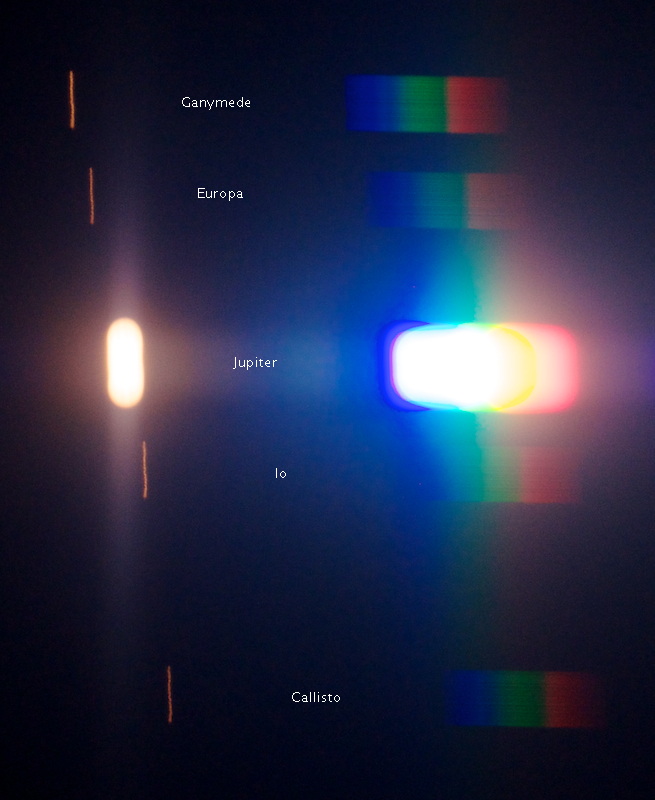
Imaging: Jupiter Galilean Moons Spectra, Moon
Posted: 29 December 2012
Friday, 28 December 2012, stayed clear all day. In the morning I was able to do an ISS-Sun transit "dry run". After the sun set, I opened the observatory at 1805 MST, 48°F. At 1810 MST, I began observing Jupiter, 77X. The four Galilean Moons were visible and nicely spreadout. I began setting up for spectrum imaging of the moons using the Star Analyzer 100 and D7000 DSLR at prime focus of the 8" LX200-ACF. I wanted to try to image the spectra before the nearly Full Moon rose and brightened the sky background. This (cropped) image shows the positions of the moons, 1/5sec, ISO 200:

This is the unprocessed image (but cropped) showing the moons and their spectra, 5 seconds (using the "drift method"), ISO 1000:

These are the processed spectra for each of the four Galilean Moons:
Ganymede
![]()
Europa
![]()
Io
![]()
Callisto
![]()
By 1826 MST, the eastern sky was brightening from the soon to rise just past Full Moon. I ended spectra imaging and viewed Jupiter at 206X to check on the seeing conditions. It was pretty good so I decided to try an HD video recording of Jupiter at prime focus + 3X TeleXtender. The following is a stack of 1878 frames (78 seconds) using Keith's Image Stacker, 1/30sec, ISO 500:

The Great Red Spot is just coming into view at the lower right of the planet's limb.
At 1848 MST, the moon had appeared over the hill to the east. Very bright moon, about 14 hours past Full. I switched to using a focal reducer and the visual back, but would wait for the moon to rise higher before beginning to image it. I added the moon filter to the 26mm eyepiece, which eliminated the "pain" of viewing the bright moon through the telescope and made for more comfortable viewing of details on the moon's surface. A slight terminator was visible. At 1900 MST, with the temperature 40°F, the iPod that had been playing music from the TV show "Space: 1999" (appropriately), shutdown due to the low temperature. I continued lunar observing until 1914 MST and then began imaging with the D7000 DSLR. This is a cropped, 1/320sec, ISO 100, "natural" image of the moon:

This is an enhanced color saturation version of the same image as above to bring out the colors of the different areas on the moon:

The slight terminator is visible at the upper right in both images.
I finished imaging at 1918 MST, removed the visual back and focal reducer, and switched to the star diagonal. Continued lunar observing, 77X, with the moon filter. I then viewed the terminator at 206X. At 1927 MST, viewed Jupiter, 77X, moon filter. The moon filter reduced the brightness of the planet allowing for better viewing of the cloud bands. The Great Red Spot was clearly visible now.
A strong breeze had come up and I ended this session. The observatory was closed at 1941 MST, 39°F.
Comments are welcome; use the Comments section below, or you can Email Me. Thanks.
Go to the previous report.
Return to the Cassiopeia Observatory Home Page.